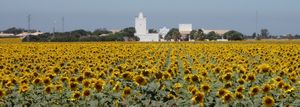Advertisement

 Sunflower fields
Sunflower fields
We passed countless numbers of bright yellow sunflower fields on our drives through Spain. Most will become sunflower oil. Monday, Jun 13th - Tuesday, June 14th. After a weekend being transported to the 18 century on the dusty roads of tiny El Rocio we were ready for the beaches of nearby Costa de Luz. It was so refreshing to feel the sea air as we reached the coast. We stopped off in Cadiz for lunch on the way. Cadiz is a small peninsula where high rises link old world buildings and beautiful beaches. We ate at a busy seaside spot called, La Merea. I had some delicious Pulpo Gallego and John had Bacalao Dorado. After lunch we had a brief siesta on the warm beach. That afternoon we settled into a little bungalow in the seaside village of Los Canos de Meca. When searching for the bungalow we found an ideal little place called Pura Vida. We were enamored driving up the small winding path as the place was cute and immaculate. We were bummed to find out the place was full after speaking with the owner. However on our way back to our car we were actually relieved. As we scoped the premises and the inviting pool, we noticed that we were checking out a clothing optional establishment. The

 Alcazar - Los Baños de Doña María de Padilla
Alcazar - Los Baños de Doña María de Padilla
The "Baths of Lady María de Padilla" are rainwater tanks beneath the Patio del Crucero. The tanks are named after María de Padilla, the mistress of Peter the Cruel. Supposedly, Peter fell for María and had her husband killed. María resisted his advances and poured boiling oil over her face to disfigure herself to stop Peter's pursuit. She became a nun and moved to a convent afterwards. She is regarded as a symbol of purity in the culture of Seville.small town is full of charm with little cafes and shops spread along the coast but none more than two stories high in order to preserve the natural beauty area. The white sand beaches were beautiful and uncrowded. We spent the next day enjoying the beach. We had a secluded spot where we chilled in the hot sun and swam in the chilly turquoise waters.
Wednesday, June 15th, we went to the Southern tip of Europe, Tarifa. It is a medieval city with a peninsula that marks the Southern most point of continental Europe. It is also a spot where the Mediterranean and the Atlantic meet. From the shores, you can see the outline of mountainous Morocco on the African continent. It is a really interesting place. We walked around the narrow streets of the old city and walked on the beaches on the Mediterranean Sea and the Atlantic Ocean. We found a marina side café with a view of Africa where we stopped to have some tapas: octopus salad, bean salad with tuna and a stuffed mushroom with a fried quail egg with a chilled glass of Albarino wine. We explored the beach towns of Zahara de los

 An entrance of the Salon de Embajadores
An entrance of the Salon de Embajadores
All part of the Alcazar (Palace of Seville)Atunes and Barbate. We stopped to dwell on the beach before heading back to our bungalow.
Thursday, June 16th, we headed to Seville (Sevilla), situated on the plain of the River Guadalquivir. We just spent the day checking out the city and mainly seeing the impressive royal palace, The Alcazar of Seville. The Alcazar, originally built in the 12th century, houses an elaborate royal palace and expansive gardens. We were most impressed by the intricate design of the Salon de Embajodores and Patio de las Munecas. We found a grassy spot at the outskirts of the garden to have a picnic lunch among the passing peacocks. We also walked around the beautiful Cathedral where Christopher Columbus is said to be buried. That evening as we were leaving Seville to cross into Portugal we hit major traffic. The exit we needed was closed as were the others miles up the road. Traffic was at a standstill. We were searching for the culprit when we noticed white covered wagons and horses on the other side of the freeway. It was a passageway for the pilgrims returning from Romeria del Rocio. Great to see that modern day development and traditions of the
past can coexist in this culture.
Advertisement
Tot: 0.105s; Tpl: 0.013s; cc: 9; qc: 24; dbt: 0.0743s; 1; m:domysql w:travelblog (10.17.0.13); sld: 1;
; mem: 1.2mb

 Sunflower fields
Sunflower fields
 Alcazar - Los Baños de Doña María de Padilla
Alcazar - Los Baños de Doña María de Padilla
 An entrance of the Salon de Embajadores
An entrance of the Salon de Embajadores







J Krempasky
non-member comment
Happy Trails
Fabulous, darling---simply fabulous! I'm enjoying your trip from my couch. Thanks for all the beautiful & interesting photographed places (it actually looks like you are on a movie location). See you soon. Peace be with you, Julie